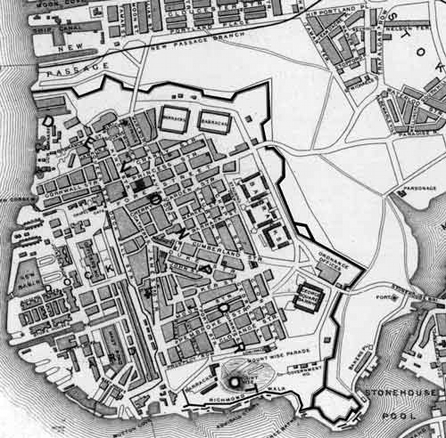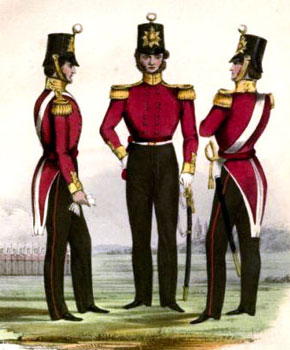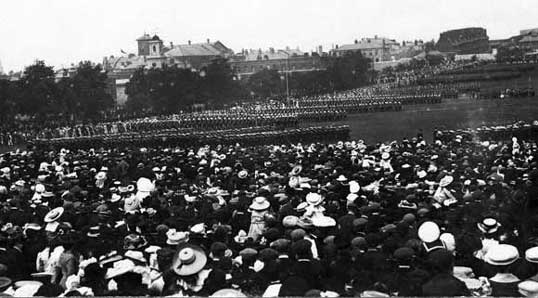Plymouth Dock - A Garrison Town
Overview
Typically, Devonport/Plymouth Dock is considered first and foremost a naval town - both by our own local residents, and by non-residents. While that remains true, Devonport was and still is a naval district and dockyard area, there is a period in our history when we were also recognised as one of England's major garrison towns. And that period is not too far in our past.......
This 1850 map, below, presents the situation very clearly. On one side, to the west, we were hemmed in by the Admiralty; they had claimed almost the entire river frontage for the dockyard and navy. On the north and east we were surrounded by the Army, with a series of barracks encircling the land side of Devonport. The thick black line outside of the barracks, surrounding the town, was the garrison wall - in some places 20 foot high, in other places 30 maybe 40 foot high. Residents called this wall 'The Lines'. The Lines were built with one purpose - as defensive fortifications surrounding Devonport to protect the dockyard from attack. Abutting the outside of the garrison wall was a dry moat/ditch. Finally there was the glacis - a wide band of grassland arcing around the entire town - shown on the map as plain white space with footpaths across it.

Devonport - extracted from the Map of Plymouth, Devonport and Stonehouse engraved by Rapkin, published by Tallis c1850
Although residents of the period were virtually hemmed in, (for many years the only land exit was via drawbridge) I prefer to think of them as being protected. I suspect that the isolation created by both the garrison wall, and by the green arc beyond that, nurtured a territorial culture that exists to this day. Devonportees, of all residents within Plymouth, have the strongest sense of place.
For 140 years the townsfolk of central Devonport lived inside the walls - and if you were born inside the garrison, 'within the Lines', you were a true Devonportee. As the town grew and expanded with the new build of Morice-Town, Stoke, etc., then of course many Devonport people were born 'without the Lines' - this adding to Devonportees' sense of place, whether you were born 'Within or Without'.
A Colourful Scene
Throughout the 18th and 19th centuries Plymouth Dock was crowded with soldiers -
with Infantry (Marlborough, Granby and Cumberland barracks), Royal Engineers and
Artificers (Frederick Square barracks), Royal Artillery (Legonier Square barracks),
and in Mount Wise barracks were the Royal Engineers' workshops. Around 1854 began
the build of Raglan barracks, replacing Frederick, Legonier and Cumberland barracks.
Raglan held 2000 men and their officers, that is, two full regiments. The garrison
church in nearby Cumberland Road could seat 1000 men. The town was indeed crowded.
Can't you just imagine the colour and spectacle of life in Devonport then? Unlike
today, uniforms then were worn both in and out of barracks. Also, uniforms and military
costumes during those centuries were more flamboyant and colourful than now. The
grandeur of dress was important to each regiment - little touches here, more feathers
in the hat maybe, more buttons, badges or gold braid... Regiments would scrutinise
each others’ uniforms minutely. Myerly 1996 commented ** When an officer appeared
one Sunday evening (c1804?) at the Plymouth Dock promenade wearing hussar boots
with a silk tassel hanging from the pointed brim, Captain Mercer wrote: "I shall
not in a hurry forget the sensation caused ... ‘Oh, the puppy!’ was heard on all
sides. ‘If he has not silk tassels to his boots! Only think! Silk tassels on boots!’*
Such pride in their outfits enhanced the Esprit de corps of a company or regiment.
It was all part of the spectacle, an ever changing spectacle, since regiments moved
in and out of Devonport constantly - some stayed only months, some years, some returned
regularly for long stays, such as the Devon & Cornwall Light Infantry. There were
Regiments of Foot, Rifle Regiments, Volunteer regiments, the Plymouth Dock regiment,
the Plymouth Dock Cavalry, the list goes on. The town was alive with colour, mostly
red.

The 46th Foot Regiment c1850
Next are two wonderful images to leave you with a lasting impression of Devonport/Plymouth Dock as a garrison town.
Review of the Troops. Lower Brickfields. Frith 1871. The photographer had his back to Devonport Hill. The road lined with spectators, across the top right corner, is Kings Road. Military reviews were a regular and popular feature of life in Devonport - always well attended by residents. The Reviews were held on both parts of the Brickfields, upper and lower.

Review of the Troops. Upper Brickfields. 1912. The audience of thousands stand on part of Devonport's green arc - what was once the glacis - this section today is Plymouth Albion Rugby grounds. The garrison Lines, no longer standing by 1912, would have been visible where the row of trees stretch across left of picture.
Newspaper Articles
Some newspaper articles c1800-1824 providing a flavour of the garrison and military nature of Plymouth Dock.
A Splendid Ball.
Yesterday the Honourable Colonel Onslow, and Lieutenant Colonel Sir John Frederick,
Bart. of the 2nd Royal Surrey regiment, gave a splendid ball and supper at Cowley’s
Royal Crown Hotel, Dock, to a numerous and fashionable assemblage of the nobility,
gentry, officers of the army and navy, and their ladies, resident at Plymouth, Dock,
and environs. Dancing continued to a late hour. The supper consisted of all the
delicacies of the season: the desert was magnificent, and the wines excellent; and
the company departed with regret after a most pleasant evening.
Troops Under Arms Assembled in Fore Street (article 1)
We have received the following statement of the riot which took place at Plymouth Dock, on Tuesday last the 31st ult. It being market day a number of persons assembled in a tumultuous manner, and not contented with taking different articles of provisions, at their own prices, proceeded to attack the bakers shops, breaking the windows and plundering the bread. Application being made by the Magistrates for military assistance, detachments from the picquets of the Wiltshire, and First Devon regiments of Militia, with a squadron of the Queen’s Bays, were immediately sent into the town, and some women and men were taken in the act of thieving and rioting by the Constables, and lodged in the main guard.
The tumult still continuing the riot act, after some time was read, and one man seized, who was particularly active at the head of the mob. It is believed the business would have ended here, but about four o’clock, on the Dock-yard men coming out of the yard the tumult again commenced; joined by the yardsmen, they proceeded towards the Main Guard, with the avowed purpose of liberating the prisoners. The cavalry and picquets were however thrown across the street, and prevented their approaching nearer than within about a hundred yards of the guard-house. But no entreaties could prevail on the mob to retreat or disperse, with the utmost insolence they braved the military, and dictated to the Magistrates, who at length complied with their demands, and liberated the whole of the prisoners, a compliance, which, whatever might be the motive, may eventually produce more real evil, than firmer measures would have done. The infatuated people concerned in this disgraceful riot, little appreciated the danger they were in.
Several field pieces loaded with grape and canister shot were brought, unknown to them, to bear upon them, and a few minutes would have been sufficient to have sent hundreds of them in an instant before that God whose religion proscribes tumult, and enjoins obedience to the laws. It is but justice to add, that the troops of the garrison under arms, together with the Dock Associated Cavalry, behaved with a steadiness and patience not to be surpassed; they waited in silent expectation of orders to act, and were most heartily disposed to have vindicated the injured laws, tranquility, and character of their country.
Tuesday Evening, April 7. Dock is perfectly quiet. The Dock-yard men have printed an apology for their conduct; so that we trust all tendency to riot, is now at an end.
Troops Under Arms Assembled in Fore Street (article 2)
Tuesday, April 7. Wind S.W. hard rain, Last night late, in apprehension of a riot
at Dock, General England issued orders to all the troops, volunteer and associated,
and cavalry and infantry of Plymouth, Dock Stonehouse and Stoke, to be under arms
on their different parades at nine o’clock. At 6 o’clock this morning the Queen’s
Dragoons, Royal Artillery, Wilts, and Devon Regiments, Dock Cavalry and Infantry,
with four light 9 pounders and two howitzers, assembled in Fore-street; at Stonehouse,
Pridhatu’s Volunteers; at Stoke, Scobell’s Royal Artillery; in their barracks, the
North Hants, the Bedford, and 2nd Royal Surrey assembled; on the glacis here, the
Plymouth Regiment of Volunteers, Col. Hawker, Langmead’s Volunteers, Plymouth Blues,
Major Culme, Plymouth Rangers, Major Julian, Plymouth Cavalry, Captain Hilley, assembled
in great strength, and sent their returns to General England by Lieut, Colonel Hawker.
The General was so pleased at the alacrity in turning out so respectable a body
of men under arms, that he sent a very handsome letter to all the volunteer corps,
with his particular thanks, and desired their respective commanding officers to
dismiss them for the present, as Dock was very quiet, but to be in readiness to
turn out at a moment’s warning, if necessary. Too much praise cannot be given to
the corps of all description for their promptitude in getting under arms. This day
the Butchers agreed to sell meat on the 13th instant for 7d. per lb.; and the Bakers
to sell their flour at 1s.10d. the quarter of 7 ½ lb. And at 3l.3s. per sack.
3000 Army Reserve garrisoned at Dock
Three thousand of the Royal Army of Reserve is the number to be in garrison here, part of which are already marched into George’s and Granby squares; the whole are to be attached, for the present, to the 9th and 28th regiments of foot, to learn their exercise. Volunteering, in lieu of the army en masse, is at present suspended, from the overflow of patriotic offers from all parts of this opulent and loyal country to the Lord Lieutenant; the number of volunteers is fixed at 9072, six times the force of the present militia, for the country; 15,000 volunteers were enrolled, and the offers of their services made, previous to the 11th instant, to the Government. Their numbers were as follow: For Plympton, Ermington, Stanborough, Coleridge, and Roborough, cavalry and infantry, 2650; Plymouth, 1000 infantry at Plymouth-Dock, 500 infantry; besides several other smaller corps of infantry, riflemen, artillery, &c. His Majesty, pleased with the exertions of the United Kingdoms in rising like one man to defend their dearest rights against the efforts of a Corsican usurper, has been highly gratified at the exertions of the country of Devon, and particularly of the above hundreds, and the towns of Plymouth, Dock, and their environs.
The Plymouth Dock Cavalry
Yesterday the drawing for 44 men for the army of reserve began at the Guildhall. A great number of the militia have turned out volunteers for the navy. The Plymouth-Dock cavalry exercise outside the Higher Barrier, a fine body of dashing horses and riders, are instructed by the dragoons quartered at Dock, and get on very fast. R. Fuge, Esq. has called a meeting of the inhabitants, at the London Inn, to form, in the present important crisis, a military foot association, similar to that of last war, which was well attended. Another meeting takes place this evening. J. Hawker, Esq. has also called a meeting to form a regiment of volunteers, of eight companies, of 60 men each, with leave to add 20 more, if to be procured hereafter. Lieutenant General Simcoe very much approves of the plan.
Plymouth Dock Loyal Volunteers
Plymouth-Dock. Oct. 19. The Plymouth-Dock Loyal Volunteers, consisting of about 600, commanded by Lieut. Col. Foot, were inspected by Colonel Gore, on Wednesday last: after which the Rev. Jonathan Williams, Chaplain to the corps, and one of the Magistrates for the parish of Stoke Damerel, &c. administered to each of them the Oath of Allegiance. They were on the ground from one o’clock ‘till seven; and on Sunday the corps received their arms. The whole will be cloathed in about three weeks. Their uniforms from a pattern jacket of the 9th Regiment of Foot.
The Officers of the 3rd Foot Guards,
gave a splendid dinner at their mess-room, in Marlborough-square barracks, to the
nobility and gentry of the neighbourhood on Tuesday last. Among the company present,
were Major-General Sir J. Cameron and Staff, Earl Grey, Hon. Mr. Grey, Colonel Vinnicombe,
R.M. Colonel Morshead, R.R., Colonel Hawker. R.A., Colonel Barlow, 61st Regt., Capain
Bruce, R.N. Hon. Captain Stopford, R.N., &c. &c. The dinner was excellent, consisting
of every delicacy of the season, and the room was splendidly fitted up on the occasion
with variegated lamps and evergreens.
© Liz Cook June 2009
** Scott Hughes Myerly. 1996.
British Military Spectacle: from the Napoleonic Wars through the Crimea.
Page 46. Harvard University Press.